Building and Construction Report: Planning, Inspection, and Services
VerifiedAdded on 2021/06/16
|11
|2240
|19
Report
AI Summary
This report provides a comprehensive analysis of building and construction processes. It begins with a detailed demolition plan, outlining the necessary steps and regulations, including safety measures, preparatory dismantling, equipment installation, execution, and material recycling. The report then addresses various building codes and regulations related to wind load, bushfire protection, and earthquake resistance. It also includes a site inspection checklist, covering erosion and sediment control, development approvals, and site management. Furthermore, the report lists and describes essential building services such as energy supply, air conditioning, lighting, water supply, and communication systems. Finally, it presents an inspection checklist for system quality, covering various aspects of construction like footing, timber floor, framed roof, concrete floor, timber frame walls, and masonry walls, ensuring adherence to quality standards and construction best practices. The report references various Australian standards and codes of practice to ensure compliance.
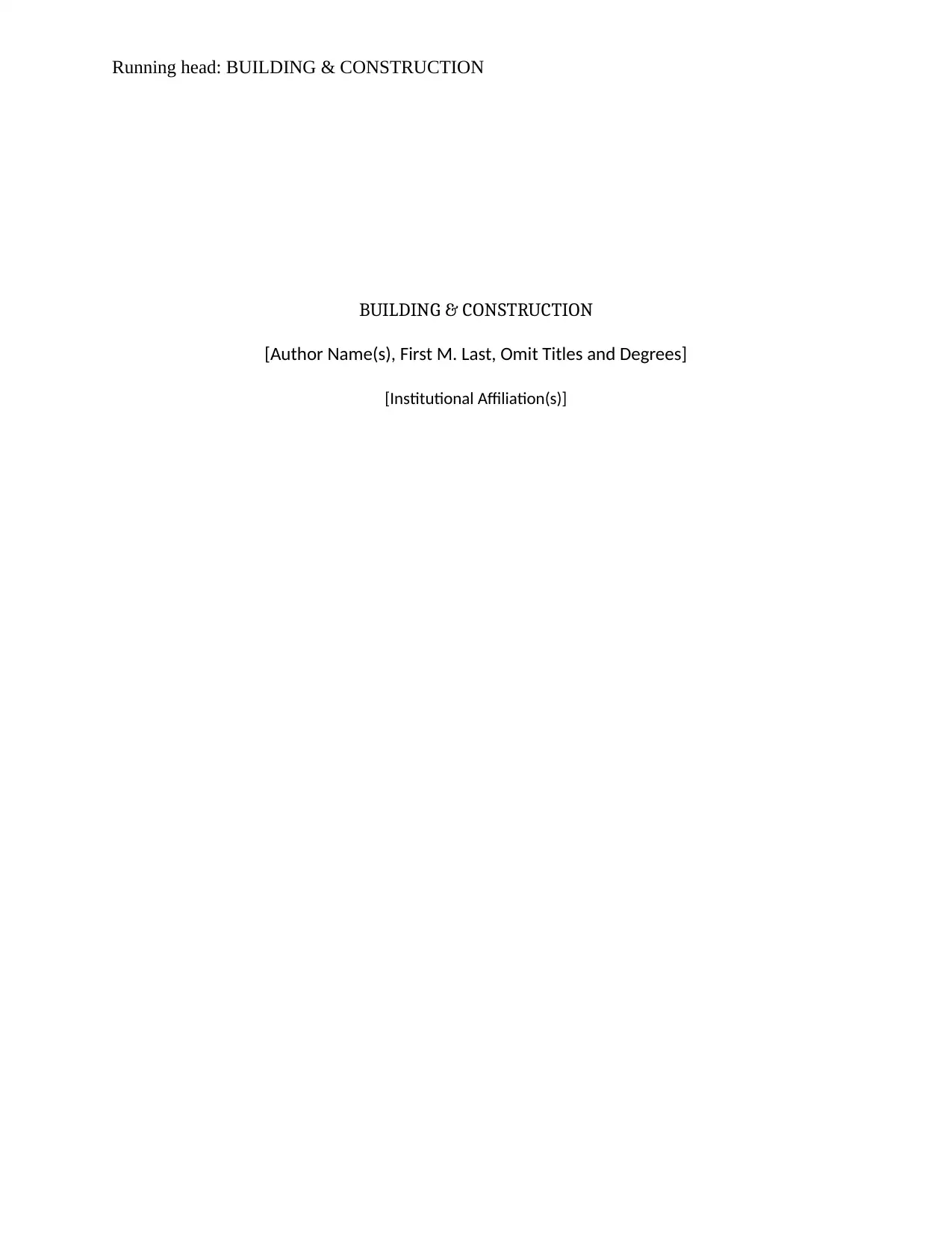
Running head: BUILDING & CONSTRUCTION
BUILDING & CONSTRUCTION
[Author Name(s), First M. Last, Omit Titles and Degrees]
[Institutional Affiliation(s)]
BUILDING & CONSTRUCTION
[Author Name(s), First M. Last, Omit Titles and Degrees]
[Institutional Affiliation(s)]
Paraphrase This Document
Need a fresh take? Get an instant paraphrase of this document with our AI Paraphraser
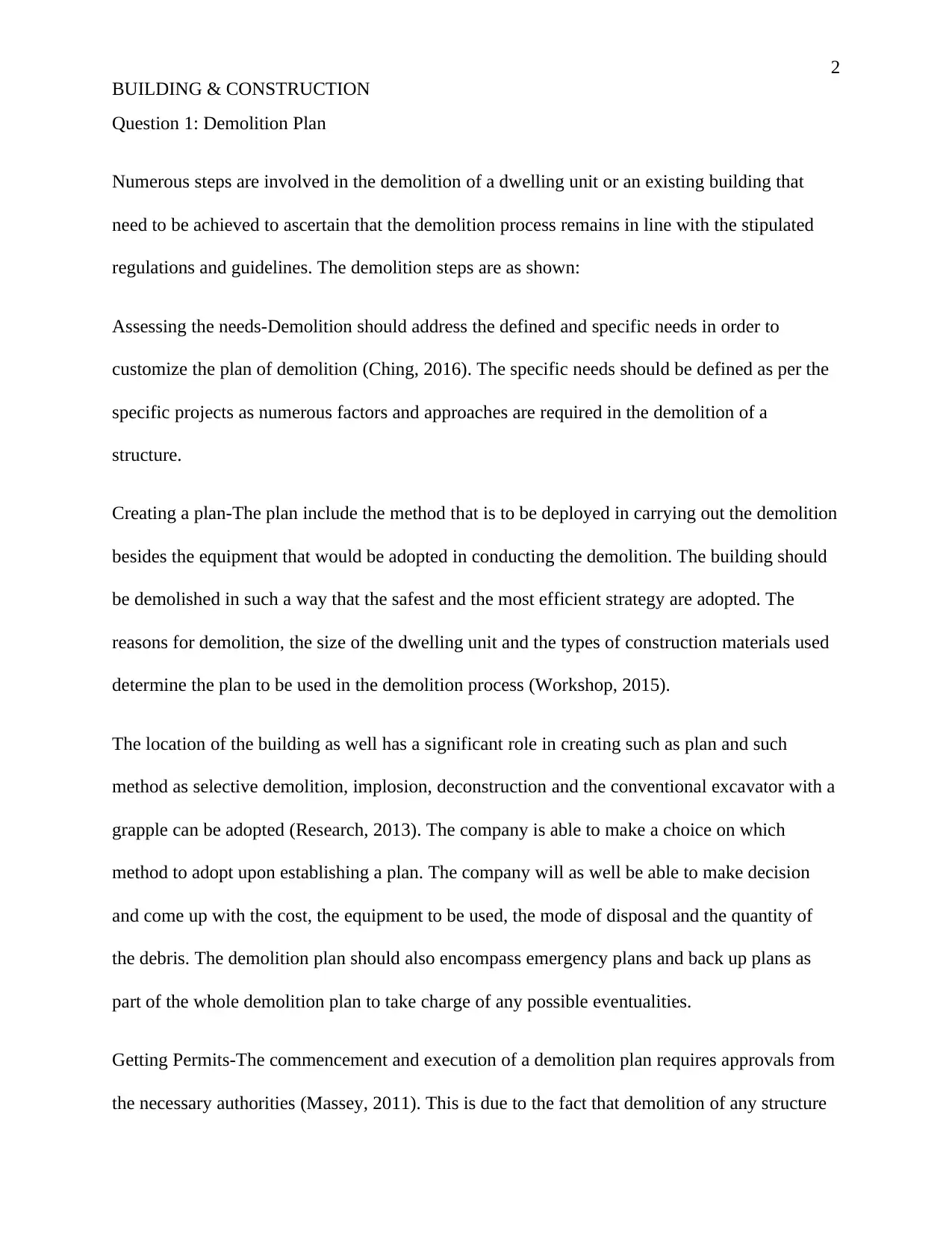
2
BUILDING & CONSTRUCTION
Question 1: Demolition Plan
Numerous steps are involved in the demolition of a dwelling unit or an existing building that
need to be achieved to ascertain that the demolition process remains in line with the stipulated
regulations and guidelines. The demolition steps are as shown:
Assessing the needs-Demolition should address the defined and specific needs in order to
customize the plan of demolition (Ching, 2016). The specific needs should be defined as per the
specific projects as numerous factors and approaches are required in the demolition of a
structure.
Creating a plan-The plan include the method that is to be deployed in carrying out the demolition
besides the equipment that would be adopted in conducting the demolition. The building should
be demolished in such a way that the safest and the most efficient strategy are adopted. The
reasons for demolition, the size of the dwelling unit and the types of construction materials used
determine the plan to be used in the demolition process (Workshop, 2015).
The location of the building as well has a significant role in creating such as plan and such
method as selective demolition, implosion, deconstruction and the conventional excavator with a
grapple can be adopted (Research, 2013). The company is able to make a choice on which
method to adopt upon establishing a plan. The company will as well be able to make decision
and come up with the cost, the equipment to be used, the mode of disposal and the quantity of
the debris. The demolition plan should also encompass emergency plans and back up plans as
part of the whole demolition plan to take charge of any possible eventualities.
Getting Permits-The commencement and execution of a demolition plan requires approvals from
the necessary authorities (Massey, 2011). This is due to the fact that demolition of any structure
BUILDING & CONSTRUCTION
Question 1: Demolition Plan
Numerous steps are involved in the demolition of a dwelling unit or an existing building that
need to be achieved to ascertain that the demolition process remains in line with the stipulated
regulations and guidelines. The demolition steps are as shown:
Assessing the needs-Demolition should address the defined and specific needs in order to
customize the plan of demolition (Ching, 2016). The specific needs should be defined as per the
specific projects as numerous factors and approaches are required in the demolition of a
structure.
Creating a plan-The plan include the method that is to be deployed in carrying out the demolition
besides the equipment that would be adopted in conducting the demolition. The building should
be demolished in such a way that the safest and the most efficient strategy are adopted. The
reasons for demolition, the size of the dwelling unit and the types of construction materials used
determine the plan to be used in the demolition process (Workshop, 2015).
The location of the building as well has a significant role in creating such as plan and such
method as selective demolition, implosion, deconstruction and the conventional excavator with a
grapple can be adopted (Research, 2013). The company is able to make a choice on which
method to adopt upon establishing a plan. The company will as well be able to make decision
and come up with the cost, the equipment to be used, the mode of disposal and the quantity of
the debris. The demolition plan should also encompass emergency plans and back up plans as
part of the whole demolition plan to take charge of any possible eventualities.
Getting Permits-The commencement and execution of a demolition plan requires approvals from
the necessary authorities (Massey, 2011). This is due to the fact that demolition of any structure
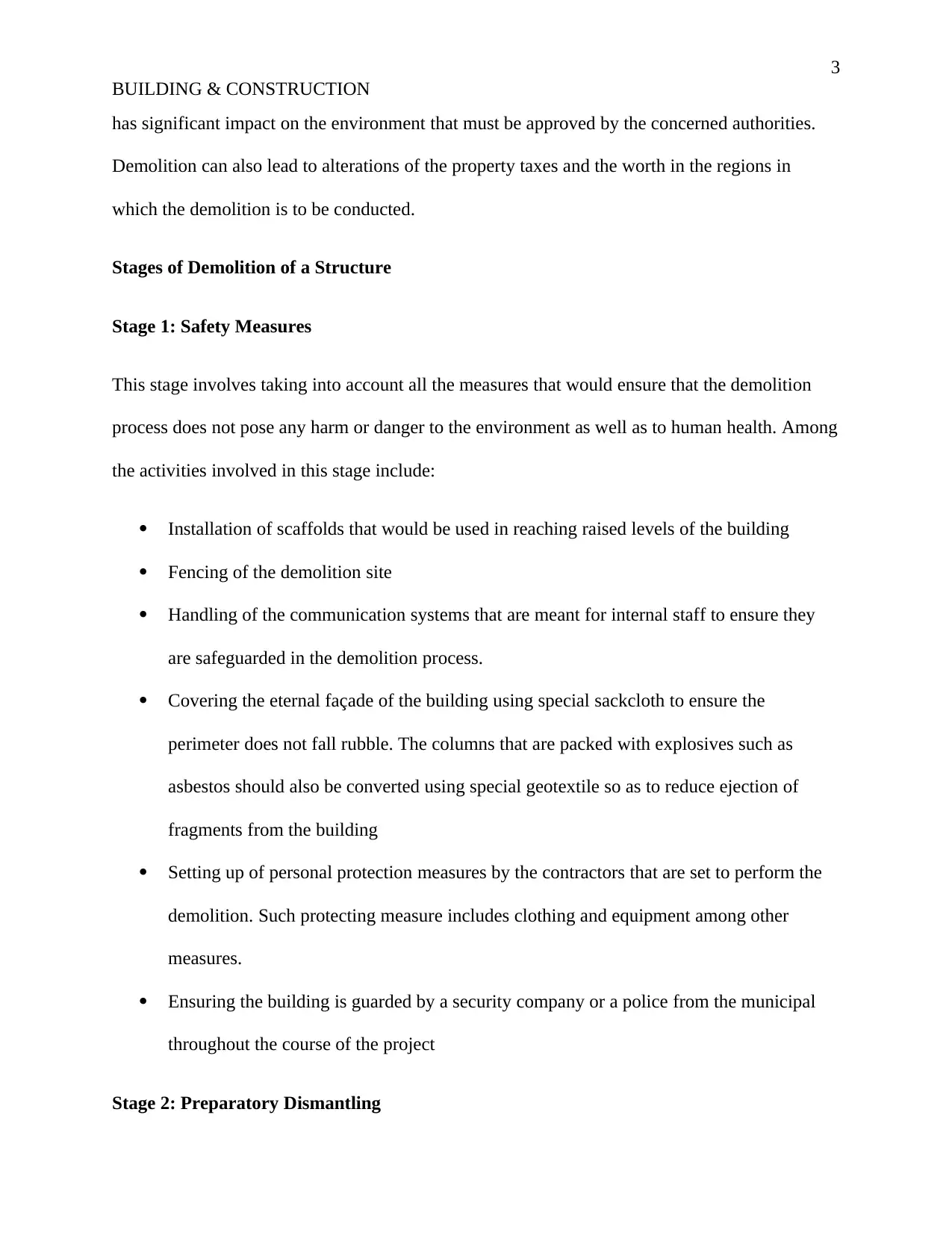
3
BUILDING & CONSTRUCTION
has significant impact on the environment that must be approved by the concerned authorities.
Demolition can also lead to alterations of the property taxes and the worth in the regions in
which the demolition is to be conducted.
Stages of Demolition of a Structure
Stage 1: Safety Measures
This stage involves taking into account all the measures that would ensure that the demolition
process does not pose any harm or danger to the environment as well as to human health. Among
the activities involved in this stage include:
Installation of scaffolds that would be used in reaching raised levels of the building
Fencing of the demolition site
Handling of the communication systems that are meant for internal staff to ensure they
are safeguarded in the demolition process.
Covering the eternal façade of the building using special sackcloth to ensure the
perimeter does not fall rubble. The columns that are packed with explosives such as
asbestos should also be converted using special geotextile so as to reduce ejection of
fragments from the building
Setting up of personal protection measures by the contractors that are set to perform the
demolition. Such protecting measure includes clothing and equipment among other
measures.
Ensuring the building is guarded by a security company or a police from the municipal
throughout the course of the project
Stage 2: Preparatory Dismantling
BUILDING & CONSTRUCTION
has significant impact on the environment that must be approved by the concerned authorities.
Demolition can also lead to alterations of the property taxes and the worth in the regions in
which the demolition is to be conducted.
Stages of Demolition of a Structure
Stage 1: Safety Measures
This stage involves taking into account all the measures that would ensure that the demolition
process does not pose any harm or danger to the environment as well as to human health. Among
the activities involved in this stage include:
Installation of scaffolds that would be used in reaching raised levels of the building
Fencing of the demolition site
Handling of the communication systems that are meant for internal staff to ensure they
are safeguarded in the demolition process.
Covering the eternal façade of the building using special sackcloth to ensure the
perimeter does not fall rubble. The columns that are packed with explosives such as
asbestos should also be converted using special geotextile so as to reduce ejection of
fragments from the building
Setting up of personal protection measures by the contractors that are set to perform the
demolition. Such protecting measure includes clothing and equipment among other
measures.
Ensuring the building is guarded by a security company or a police from the municipal
throughout the course of the project
Stage 2: Preparatory Dismantling
⊘ This is a preview!⊘
Do you want full access?
Subscribe today to unlock all pages.

Trusted by 1+ million students worldwide
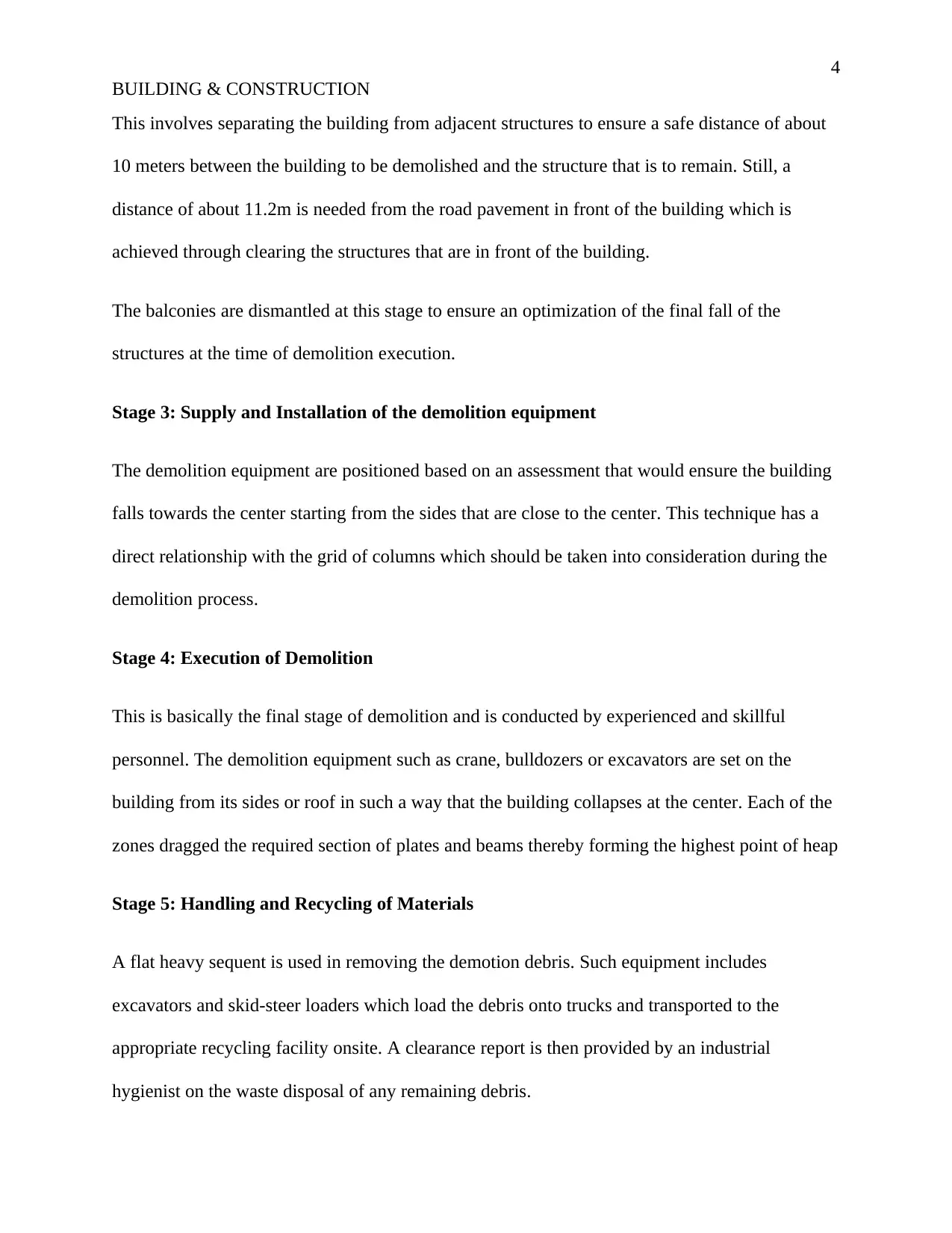
4
BUILDING & CONSTRUCTION
This involves separating the building from adjacent structures to ensure a safe distance of about
10 meters between the building to be demolished and the structure that is to remain. Still, a
distance of about 11.2m is needed from the road pavement in front of the building which is
achieved through clearing the structures that are in front of the building.
The balconies are dismantled at this stage to ensure an optimization of the final fall of the
structures at the time of demolition execution.
Stage 3: Supply and Installation of the demolition equipment
The demolition equipment are positioned based on an assessment that would ensure the building
falls towards the center starting from the sides that are close to the center. This technique has a
direct relationship with the grid of columns which should be taken into consideration during the
demolition process.
Stage 4: Execution of Demolition
This is basically the final stage of demolition and is conducted by experienced and skillful
personnel. The demolition equipment such as crane, bulldozers or excavators are set on the
building from its sides or roof in such a way that the building collapses at the center. Each of the
zones dragged the required section of plates and beams thereby forming the highest point of heap
Stage 5: Handling and Recycling of Materials
A flat heavy sequent is used in removing the demotion debris. Such equipment includes
excavators and skid-steer loaders which load the debris onto trucks and transported to the
appropriate recycling facility onsite. A clearance report is then provided by an industrial
hygienist on the waste disposal of any remaining debris.
BUILDING & CONSTRUCTION
This involves separating the building from adjacent structures to ensure a safe distance of about
10 meters between the building to be demolished and the structure that is to remain. Still, a
distance of about 11.2m is needed from the road pavement in front of the building which is
achieved through clearing the structures that are in front of the building.
The balconies are dismantled at this stage to ensure an optimization of the final fall of the
structures at the time of demolition execution.
Stage 3: Supply and Installation of the demolition equipment
The demolition equipment are positioned based on an assessment that would ensure the building
falls towards the center starting from the sides that are close to the center. This technique has a
direct relationship with the grid of columns which should be taken into consideration during the
demolition process.
Stage 4: Execution of Demolition
This is basically the final stage of demolition and is conducted by experienced and skillful
personnel. The demolition equipment such as crane, bulldozers or excavators are set on the
building from its sides or roof in such a way that the building collapses at the center. Each of the
zones dragged the required section of plates and beams thereby forming the highest point of heap
Stage 5: Handling and Recycling of Materials
A flat heavy sequent is used in removing the demotion debris. Such equipment includes
excavators and skid-steer loaders which load the debris onto trucks and transported to the
appropriate recycling facility onsite. A clearance report is then provided by an industrial
hygienist on the waste disposal of any remaining debris.
Paraphrase This Document
Need a fresh take? Get an instant paraphrase of this document with our AI Paraphraser
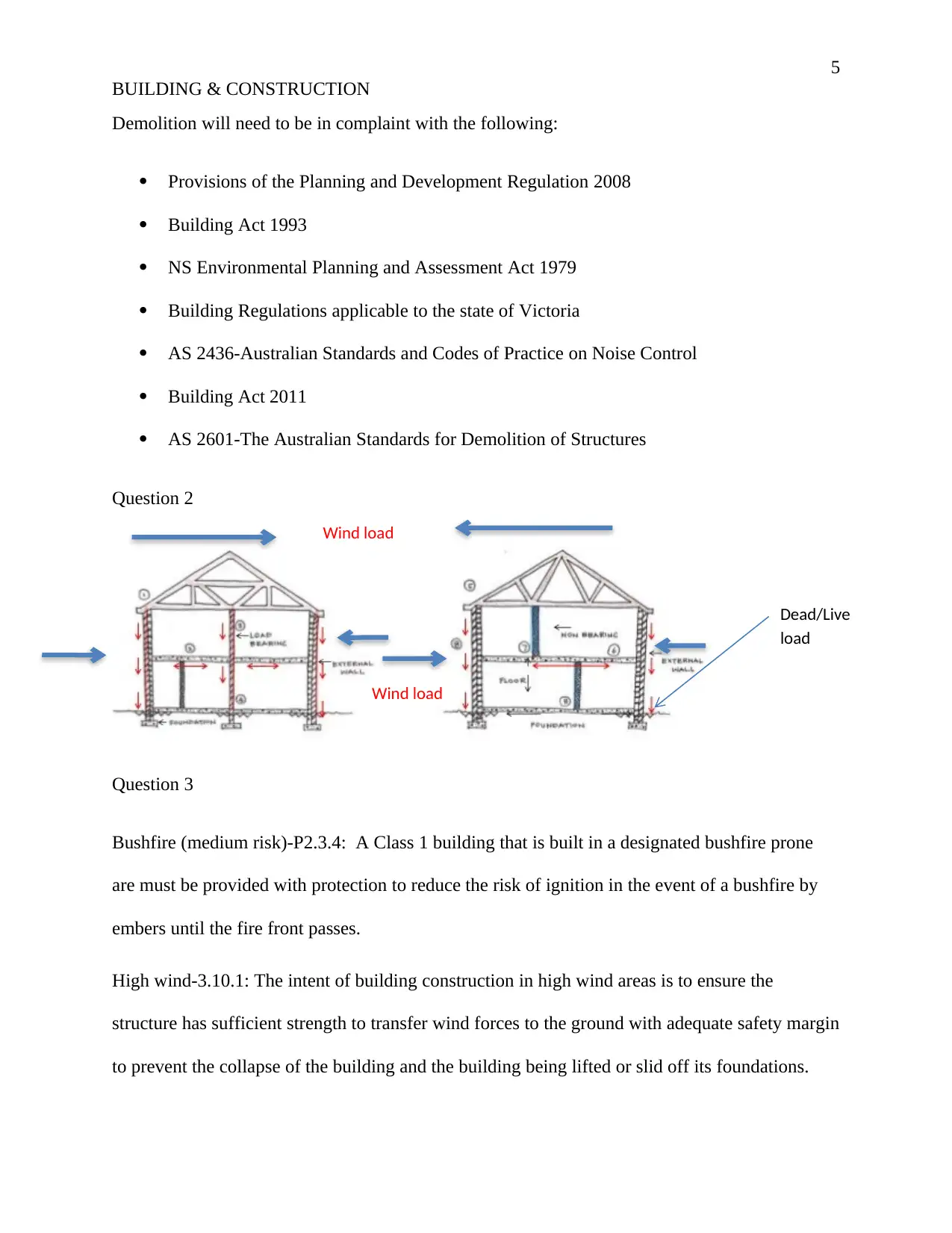
5
BUILDING & CONSTRUCTION
Demolition will need to be in complaint with the following:
Provisions of the Planning and Development Regulation 2008
Building Act 1993
NS Environmental Planning and Assessment Act 1979
Building Regulations applicable to the state of Victoria
AS 2436-Australian Standards and Codes of Practice on Noise Control
Building Act 2011
AS 2601-The Australian Standards for Demolition of Structures
Question 2
Question 3
Bushfire (medium risk)-P2.3.4: A Class 1 building that is built in a designated bushfire prone
are must be provided with protection to reduce the risk of ignition in the event of a bushfire by
embers until the fire front passes.
High wind-3.10.1: The intent of building construction in high wind areas is to ensure the
structure has sufficient strength to transfer wind forces to the ground with adequate safety margin
to prevent the collapse of the building and the building being lifted or slid off its foundations.
Dead/Live
load
Wind load
Wind load
BUILDING & CONSTRUCTION
Demolition will need to be in complaint with the following:
Provisions of the Planning and Development Regulation 2008
Building Act 1993
NS Environmental Planning and Assessment Act 1979
Building Regulations applicable to the state of Victoria
AS 2436-Australian Standards and Codes of Practice on Noise Control
Building Act 2011
AS 2601-The Australian Standards for Demolition of Structures
Question 2
Question 3
Bushfire (medium risk)-P2.3.4: A Class 1 building that is built in a designated bushfire prone
are must be provided with protection to reduce the risk of ignition in the event of a bushfire by
embers until the fire front passes.
High wind-3.10.1: The intent of building construction in high wind areas is to ensure the
structure has sufficient strength to transfer wind forces to the ground with adequate safety margin
to prevent the collapse of the building and the building being lifted or slid off its foundations.
Dead/Live
load
Wind load
Wind load
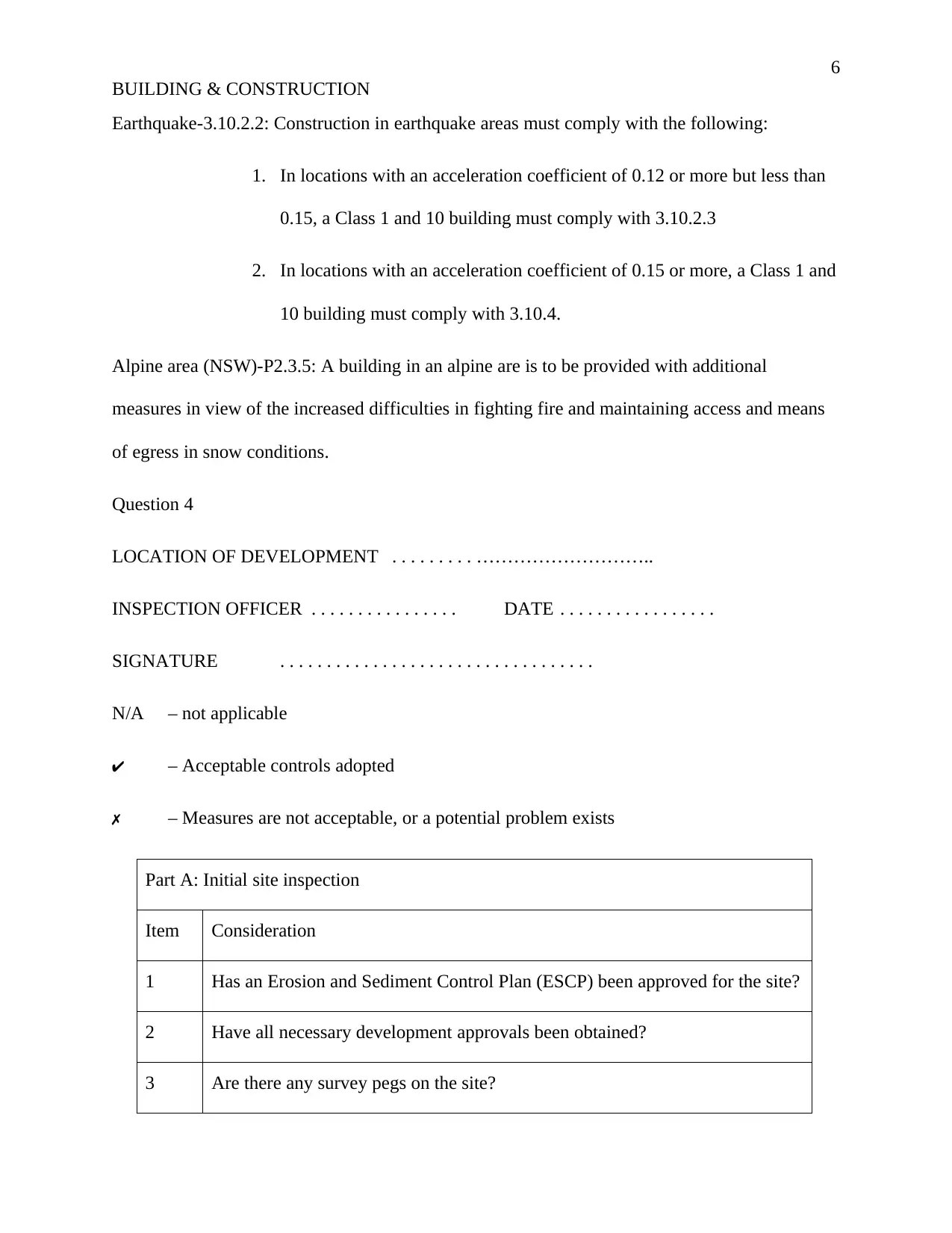
6
BUILDING & CONSTRUCTION
Earthquake-3.10.2.2: Construction in earthquake areas must comply with the following:
1. In locations with an acceleration coefficient of 0.12 or more but less than
0.15, a Class 1 and 10 building must comply with 3.10.2.3
2. In locations with an acceleration coefficient of 0.15 or more, a Class 1 and
10 building must comply with 3.10.4.
Alpine area (NSW)-P2.3.5: A building in an alpine are is to be provided with additional
measures in view of the increased difficulties in fighting fire and maintaining access and means
of egress in snow conditions.
Question 4
LOCATION OF DEVELOPMENT . . . . . . . . . ………………………..
INSPECTION OFFICER . . . . . . . . . . . . . . . . DATE . . . . . . . . . . . . . . . . .
SIGNATURE . . . . . . . . . . . . . . . . . . . . . . . . . . . . . . . . . .
N/A – not applicable
– Acceptable controls adopted
– Measures are not acceptable, or a potential problem exists
Part A: Initial site inspection
Item Consideration
1 Has an Erosion and Sediment Control Plan (ESCP) been approved for the site?
2 Have all necessary development approvals been obtained?
3 Are there any survey pegs on the site?
BUILDING & CONSTRUCTION
Earthquake-3.10.2.2: Construction in earthquake areas must comply with the following:
1. In locations with an acceleration coefficient of 0.12 or more but less than
0.15, a Class 1 and 10 building must comply with 3.10.2.3
2. In locations with an acceleration coefficient of 0.15 or more, a Class 1 and
10 building must comply with 3.10.4.
Alpine area (NSW)-P2.3.5: A building in an alpine are is to be provided with additional
measures in view of the increased difficulties in fighting fire and maintaining access and means
of egress in snow conditions.
Question 4
LOCATION OF DEVELOPMENT . . . . . . . . . ………………………..
INSPECTION OFFICER . . . . . . . . . . . . . . . . DATE . . . . . . . . . . . . . . . . .
SIGNATURE . . . . . . . . . . . . . . . . . . . . . . . . . . . . . . . . . .
N/A – not applicable
– Acceptable controls adopted
– Measures are not acceptable, or a potential problem exists
Part A: Initial site inspection
Item Consideration
1 Has an Erosion and Sediment Control Plan (ESCP) been approved for the site?
2 Have all necessary development approvals been obtained?
3 Are there any survey pegs on the site?
⊘ This is a preview!⊘
Do you want full access?
Subscribe today to unlock all pages.

Trusted by 1+ million students worldwide
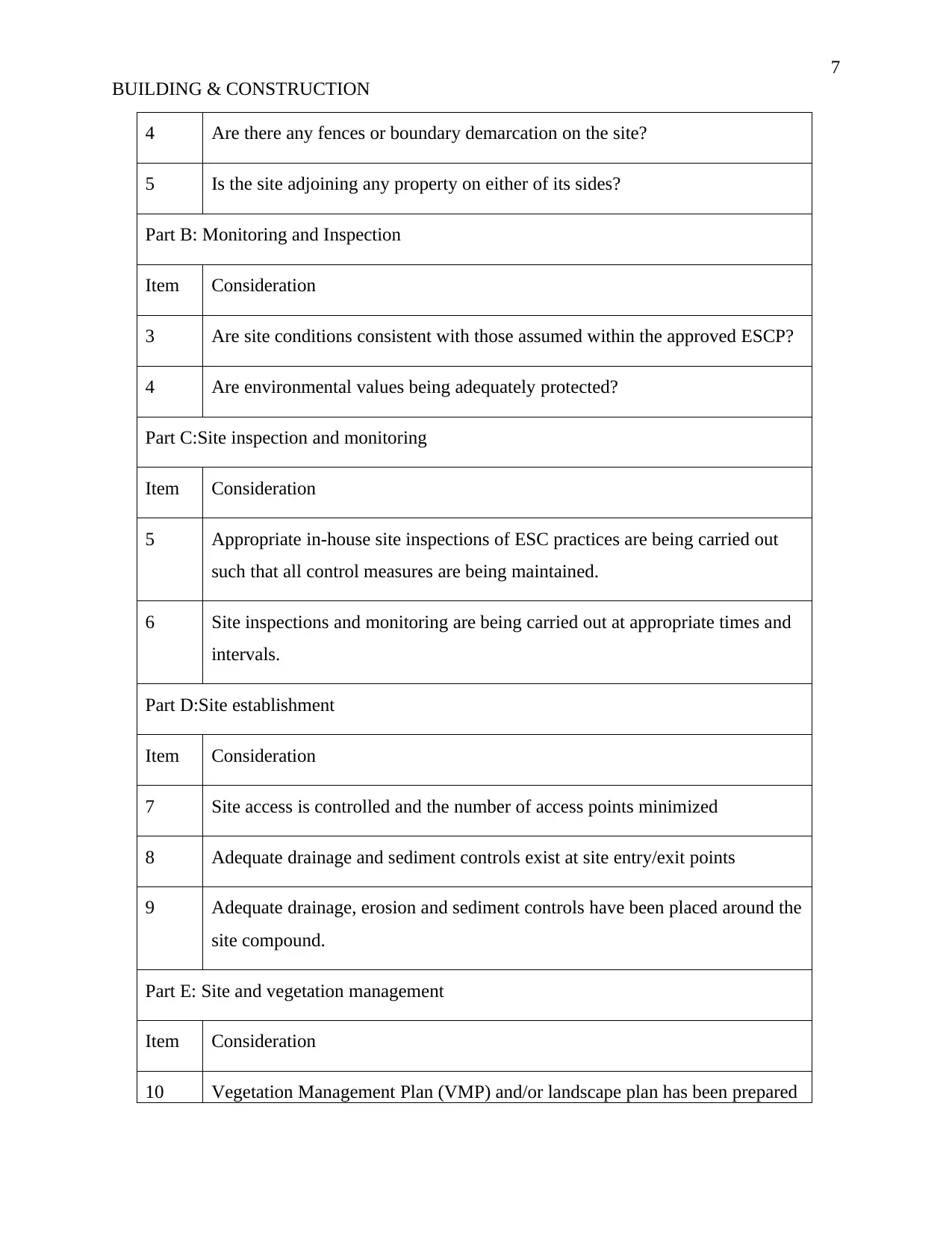
7
BUILDING & CONSTRUCTION
4 Are there any fences or boundary demarcation on the site?
5 Is the site adjoining any property on either of its sides?
Part B: Monitoring and Inspection
Item Consideration
3 Are site conditions consistent with those assumed within the approved ESCP?
4 Are environmental values being adequately protected?
Part C:Site inspection and monitoring
Item Consideration
5 Appropriate in-house site inspections of ESC practices are being carried out
such that all control measures are being maintained.
6 Site inspections and monitoring are being carried out at appropriate times and
intervals.
Part D:Site establishment
Item Consideration
7 Site access is controlled and the number of access points minimized
8 Adequate drainage and sediment controls exist at site entry/exit points
9 Adequate drainage, erosion and sediment controls have been placed around the
site compound.
Part E: Site and vegetation management
Item Consideration
10 Vegetation Management Plan (VMP) and/or landscape plan has been prepared
BUILDING & CONSTRUCTION
4 Are there any fences or boundary demarcation on the site?
5 Is the site adjoining any property on either of its sides?
Part B: Monitoring and Inspection
Item Consideration
3 Are site conditions consistent with those assumed within the approved ESCP?
4 Are environmental values being adequately protected?
Part C:Site inspection and monitoring
Item Consideration
5 Appropriate in-house site inspections of ESC practices are being carried out
such that all control measures are being maintained.
6 Site inspections and monitoring are being carried out at appropriate times and
intervals.
Part D:Site establishment
Item Consideration
7 Site access is controlled and the number of access points minimized
8 Adequate drainage and sediment controls exist at site entry/exit points
9 Adequate drainage, erosion and sediment controls have been placed around the
site compound.
Part E: Site and vegetation management
Item Consideration
10 Vegetation Management Plan (VMP) and/or landscape plan has been prepared
Paraphrase This Document
Need a fresh take? Get an instant paraphrase of this document with our AI Paraphraser
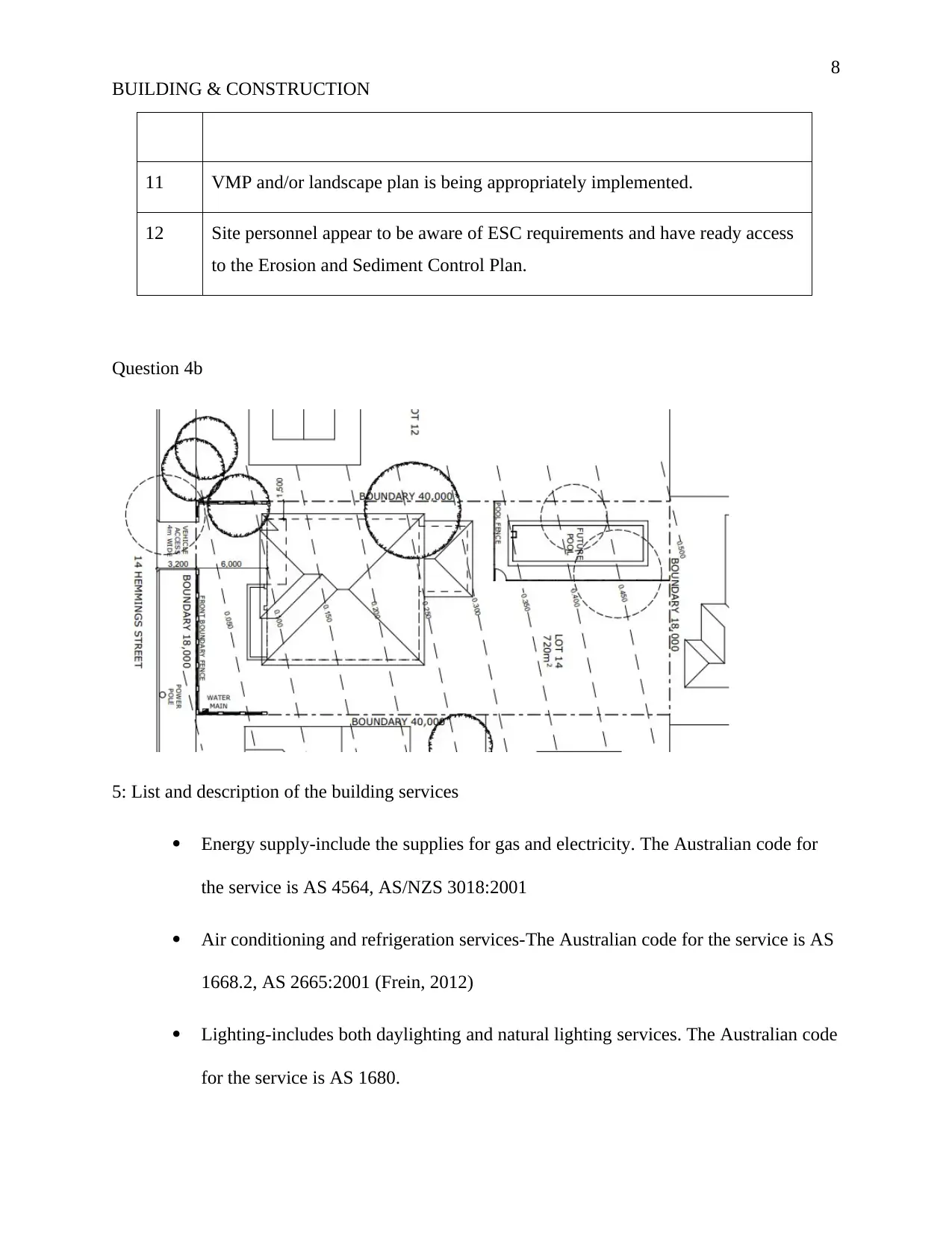
8
BUILDING & CONSTRUCTION
11 VMP and/or landscape plan is being appropriately implemented.
12 Site personnel appear to be aware of ESC requirements and have ready access
to the Erosion and Sediment Control Plan.
Question 4b
5: List and description of the building services
Energy supply-include the supplies for gas and electricity. The Australian code for
the service is AS 4564, AS/NZS 3018:2001
Air conditioning and refrigeration services-The Australian code for the service is AS
1668.2, AS 2665:2001 (Frein, 2012)
Lighting-includes both daylighting and natural lighting services. The Australian code
for the service is AS 1680.
BUILDING & CONSTRUCTION
11 VMP and/or landscape plan is being appropriately implemented.
12 Site personnel appear to be aware of ESC requirements and have ready access
to the Erosion and Sediment Control Plan.
Question 4b
5: List and description of the building services
Energy supply-include the supplies for gas and electricity. The Australian code for
the service is AS 4564, AS/NZS 3018:2001
Air conditioning and refrigeration services-The Australian code for the service is AS
1668.2, AS 2665:2001 (Frein, 2012)
Lighting-includes both daylighting and natural lighting services. The Australian code
for the service is AS 1680.
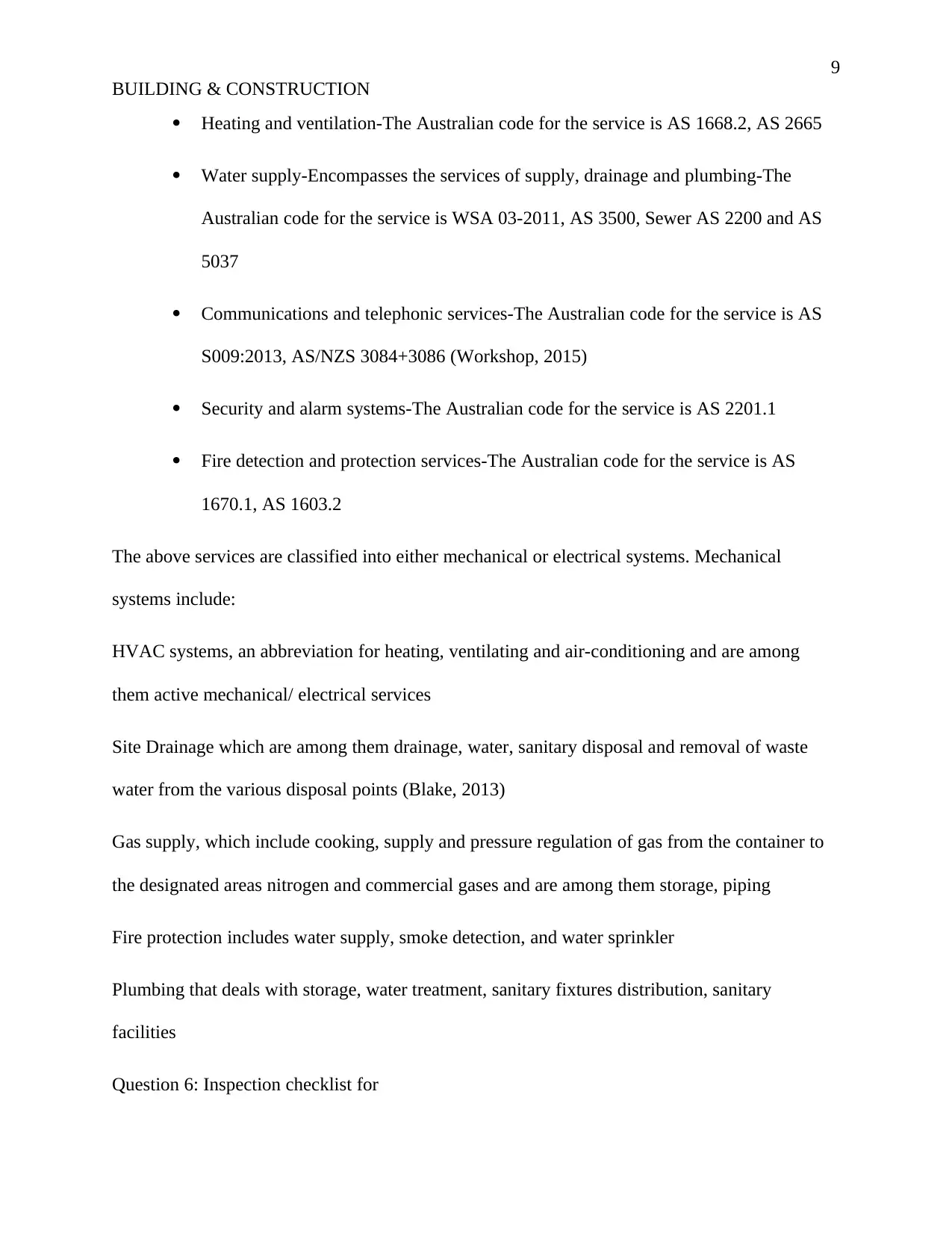
9
BUILDING & CONSTRUCTION
Heating and ventilation-The Australian code for the service is AS 1668.2, AS 2665
Water supply-Encompasses the services of supply, drainage and plumbing-The
Australian code for the service is WSA 03-2011, AS 3500, Sewer AS 2200 and AS
5037
Communications and telephonic services-The Australian code for the service is AS
S009:2013, AS/NZS 3084+3086 (Workshop, 2015)
Security and alarm systems-The Australian code for the service is AS 2201.1
Fire detection and protection services-The Australian code for the service is AS
1670.1, AS 1603.2
The above services are classified into either mechanical or electrical systems. Mechanical
systems include:
HVAC systems, an abbreviation for heating, ventilating and air-conditioning and are among
them active mechanical/ electrical services
Site Drainage which are among them drainage, water, sanitary disposal and removal of waste
water from the various disposal points (Blake, 2013)
Gas supply, which include cooking, supply and pressure regulation of gas from the container to
the designated areas nitrogen and commercial gases and are among them storage, piping
Fire protection includes water supply, smoke detection, and water sprinkler
Plumbing that deals with storage, water treatment, sanitary fixtures distribution, sanitary
facilities
Question 6: Inspection checklist for
BUILDING & CONSTRUCTION
Heating and ventilation-The Australian code for the service is AS 1668.2, AS 2665
Water supply-Encompasses the services of supply, drainage and plumbing-The
Australian code for the service is WSA 03-2011, AS 3500, Sewer AS 2200 and AS
5037
Communications and telephonic services-The Australian code for the service is AS
S009:2013, AS/NZS 3084+3086 (Workshop, 2015)
Security and alarm systems-The Australian code for the service is AS 2201.1
Fire detection and protection services-The Australian code for the service is AS
1670.1, AS 1603.2
The above services are classified into either mechanical or electrical systems. Mechanical
systems include:
HVAC systems, an abbreviation for heating, ventilating and air-conditioning and are among
them active mechanical/ electrical services
Site Drainage which are among them drainage, water, sanitary disposal and removal of waste
water from the various disposal points (Blake, 2013)
Gas supply, which include cooking, supply and pressure regulation of gas from the container to
the designated areas nitrogen and commercial gases and are among them storage, piping
Fire protection includes water supply, smoke detection, and water sprinkler
Plumbing that deals with storage, water treatment, sanitary fixtures distribution, sanitary
facilities
Question 6: Inspection checklist for
⊘ This is a preview!⊘
Do you want full access?
Subscribe today to unlock all pages.

Trusted by 1+ million students worldwide
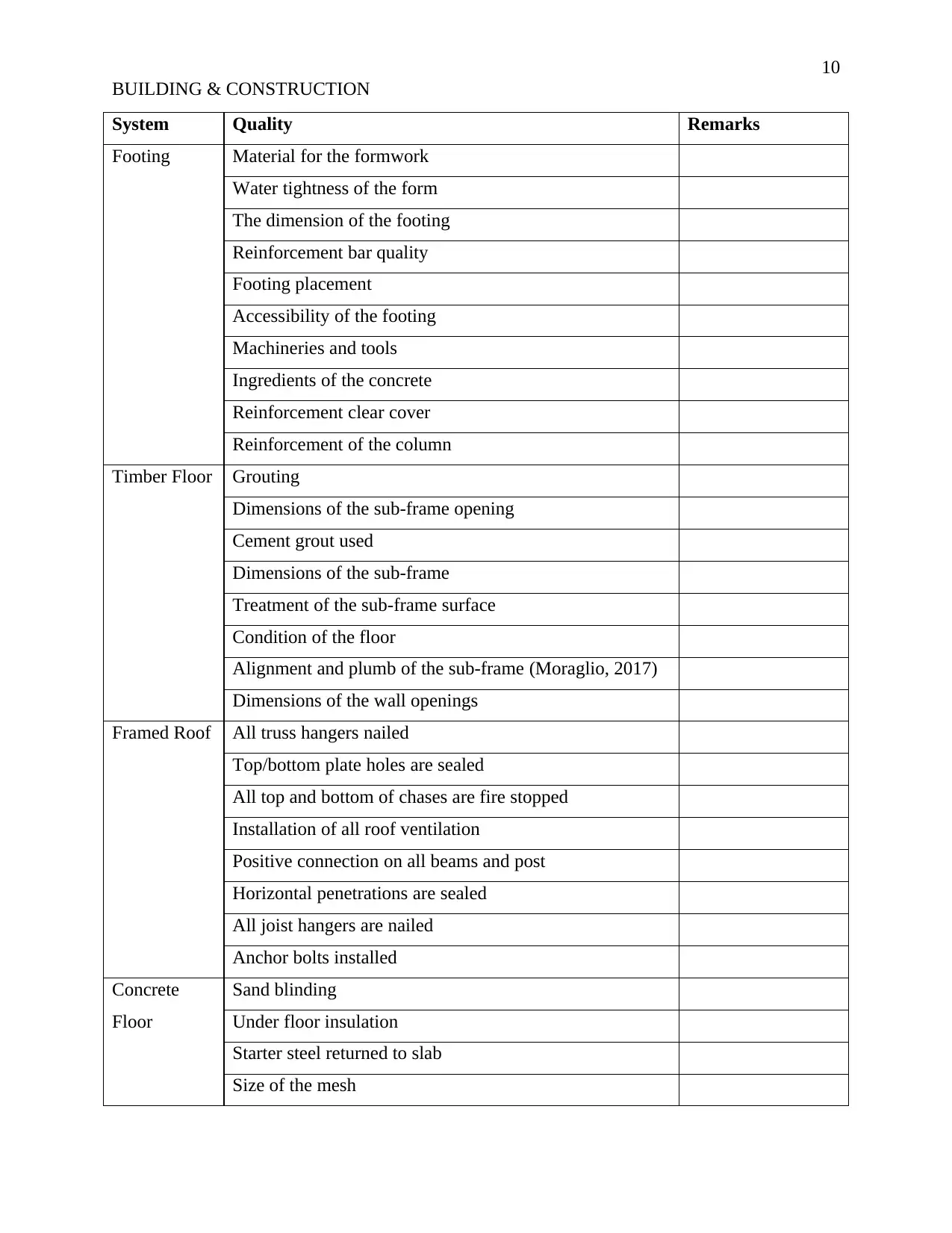
10
BUILDING & CONSTRUCTION
System Quality Remarks
Footing Material for the formwork
Water tightness of the form
The dimension of the footing
Reinforcement bar quality
Footing placement
Accessibility of the footing
Machineries and tools
Ingredients of the concrete
Reinforcement clear cover
Reinforcement of the column
Timber Floor Grouting
Dimensions of the sub-frame opening
Cement grout used
Dimensions of the sub-frame
Treatment of the sub-frame surface
Condition of the floor
Alignment and plumb of the sub-frame (Moraglio, 2017)
Dimensions of the wall openings
Framed Roof All truss hangers nailed
Top/bottom plate holes are sealed
All top and bottom of chases are fire stopped
Installation of all roof ventilation
Positive connection on all beams and post
Horizontal penetrations are sealed
All joist hangers are nailed
Anchor bolts installed
Concrete
Floor
Sand blinding
Under floor insulation
Starter steel returned to slab
Size of the mesh
BUILDING & CONSTRUCTION
System Quality Remarks
Footing Material for the formwork
Water tightness of the form
The dimension of the footing
Reinforcement bar quality
Footing placement
Accessibility of the footing
Machineries and tools
Ingredients of the concrete
Reinforcement clear cover
Reinforcement of the column
Timber Floor Grouting
Dimensions of the sub-frame opening
Cement grout used
Dimensions of the sub-frame
Treatment of the sub-frame surface
Condition of the floor
Alignment and plumb of the sub-frame (Moraglio, 2017)
Dimensions of the wall openings
Framed Roof All truss hangers nailed
Top/bottom plate holes are sealed
All top and bottom of chases are fire stopped
Installation of all roof ventilation
Positive connection on all beams and post
Horizontal penetrations are sealed
All joist hangers are nailed
Anchor bolts installed
Concrete
Floor
Sand blinding
Under floor insulation
Starter steel returned to slab
Size of the mesh
Paraphrase This Document
Need a fresh take? Get an instant paraphrase of this document with our AI Paraphraser
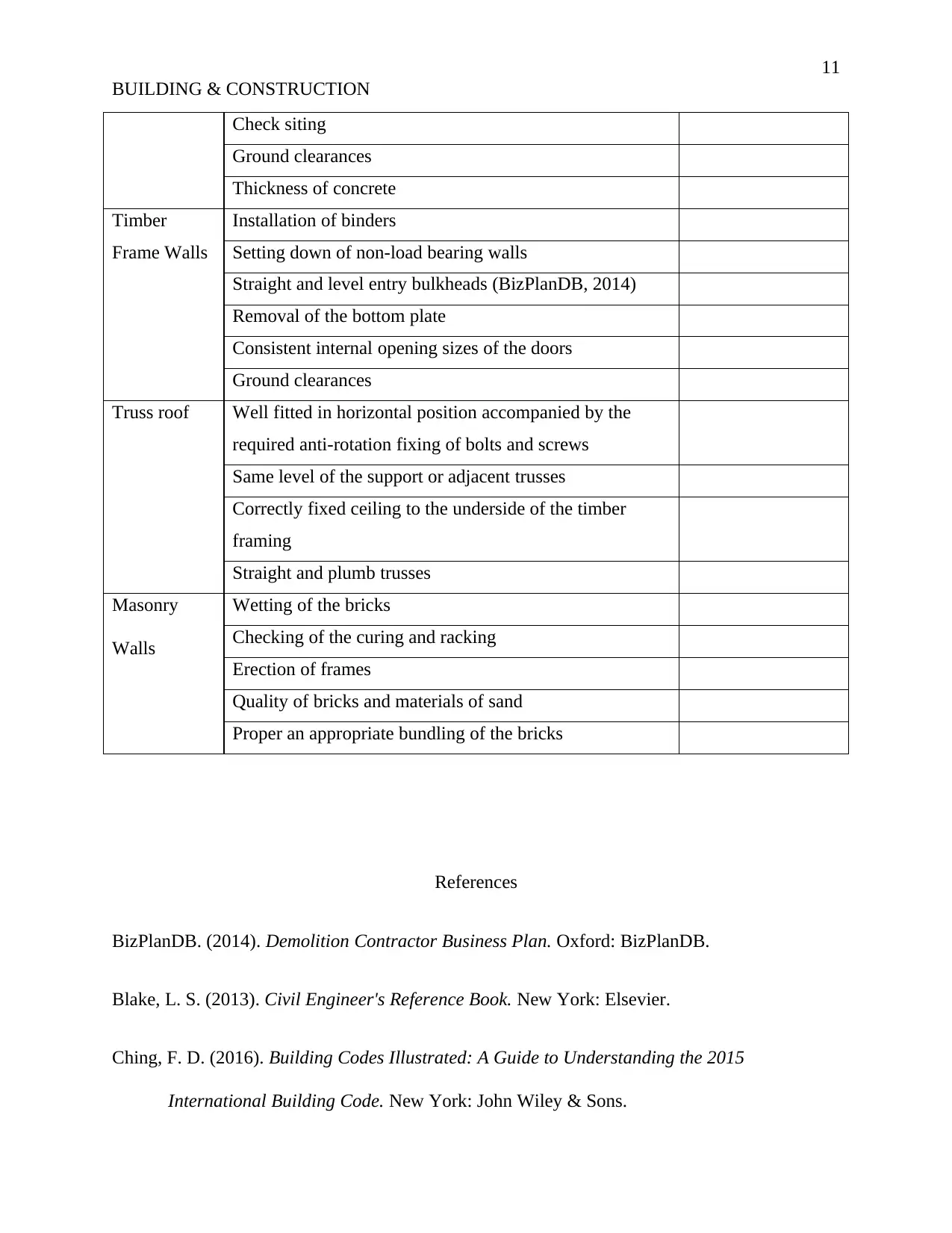
11
BUILDING & CONSTRUCTION
Check siting
Ground clearances
Thickness of concrete
Timber
Frame Walls
Installation of binders
Setting down of non-load bearing walls
Straight and level entry bulkheads (BizPlanDB, 2014)
Removal of the bottom plate
Consistent internal opening sizes of the doors
Ground clearances
Truss roof Well fitted in horizontal position accompanied by the
required anti-rotation fixing of bolts and screws
Same level of the support or adjacent trusses
Correctly fixed ceiling to the underside of the timber
framing
Straight and plumb trusses
Masonry
Walls
Wetting of the bricks
Checking of the curing and racking
Erection of frames
Quality of bricks and materials of sand
Proper an appropriate bundling of the bricks
References
BizPlanDB. (2014). Demolition Contractor Business Plan. Oxford: BizPlanDB.
Blake, L. S. (2013). Civil Engineer's Reference Book. New York: Elsevier.
Ching, F. D. (2016). Building Codes Illustrated: A Guide to Understanding the 2015
International Building Code. New York: John Wiley & Sons.
BUILDING & CONSTRUCTION
Check siting
Ground clearances
Thickness of concrete
Timber
Frame Walls
Installation of binders
Setting down of non-load bearing walls
Straight and level entry bulkheads (BizPlanDB, 2014)
Removal of the bottom plate
Consistent internal opening sizes of the doors
Ground clearances
Truss roof Well fitted in horizontal position accompanied by the
required anti-rotation fixing of bolts and screws
Same level of the support or adjacent trusses
Correctly fixed ceiling to the underside of the timber
framing
Straight and plumb trusses
Masonry
Walls
Wetting of the bricks
Checking of the curing and racking
Erection of frames
Quality of bricks and materials of sand
Proper an appropriate bundling of the bricks
References
BizPlanDB. (2014). Demolition Contractor Business Plan. Oxford: BizPlanDB.
Blake, L. S. (2013). Civil Engineer's Reference Book. New York: Elsevier.
Ching, F. D. (2016). Building Codes Illustrated: A Guide to Understanding the 2015
International Building Code. New York: John Wiley & Sons.
1 out of 11
Related Documents
Your All-in-One AI-Powered Toolkit for Academic Success.
+13062052269
info@desklib.com
Available 24*7 on WhatsApp / Email
![[object Object]](/_next/static/media/star-bottom.7253800d.svg)
Unlock your academic potential
Copyright © 2020–2025 A2Z Services. All Rights Reserved. Developed and managed by ZUCOL.





